Canon EOS 90D vs EOS M6 Mark II: DSLR vs mirrorless – how do you choose?
Canon’s two new cameras have the same internal tech but very different designs. We drill down to the real differences
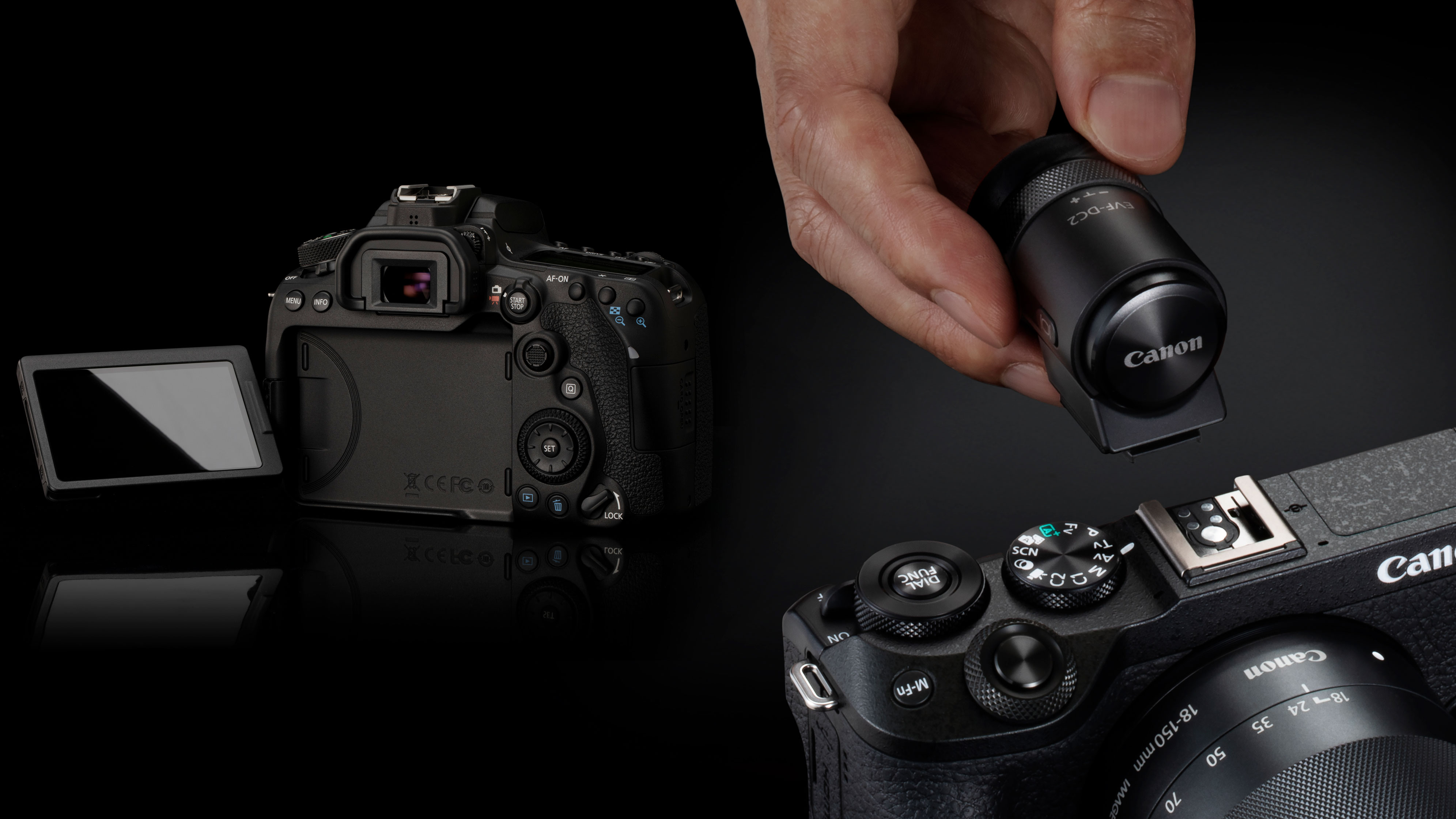
On the face of it, Canon has launched two cameras with the same sensor at the same time – the Canon EOS 90D and Canon EOS M6 Mark II. These cameras feature an exciting 32.5MP sensor that immediately takes these cameras to the top of the chart for resolution amongst all APS-C cameras, both DSLRs and mirrorless.
But which one should you choose? There’s this idea that DSLRs are on the way out, and the EOS M6 does offer the same sensor and the same new uncropped 4K video capability as the EOS 90D, as well as being both cheaper and lighter. For different reasons, they look to set to be amongst the best Canon cameras to get right now.
However, it’s not as simple as it looks. The EOS 90D has some important features and qualities which aren’t obvious if you just look at the headline specs. So here’s a detailed Canon EOS 90D vs EOS M6 Mark II breakdown that paints a much more interesting picture.
• See also: Canon EOS 90D vs EOS 80D vs EOS 7D Mark II
Specs compared
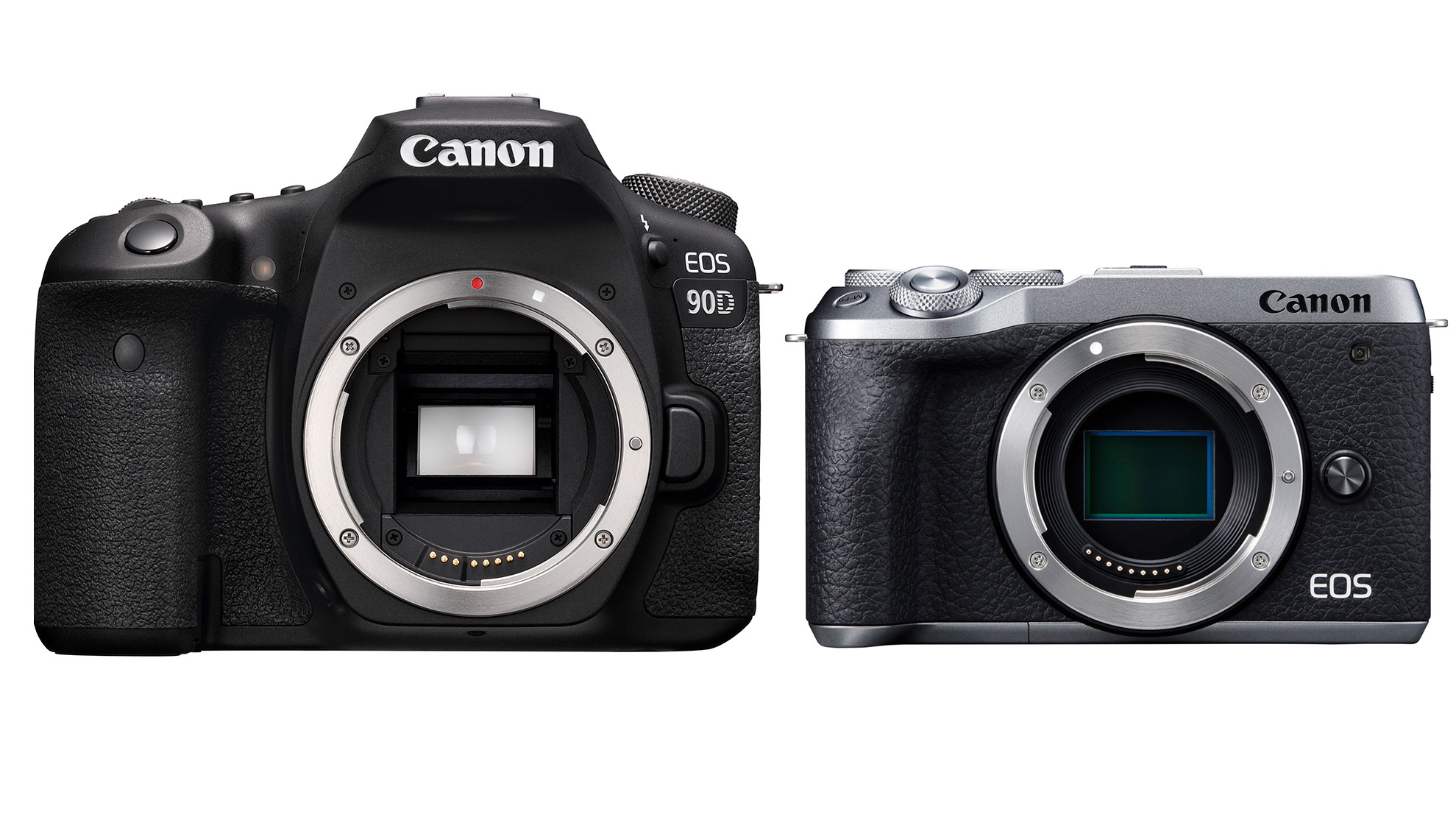
1. Sensor
Why you can trust Digital Camera World
| Header Cell - Column 0 | Canon EOS 90D | Canon EOS M6 Mark II |
|---|---|---|
| Sensor | APS-C, 32.5MP | APS-C, 32.5MP |
The Canon EOS 90D and EOS M6 use the same 32.5MP APS-C CMOS sensor, so there are no differences here. This is some way clear of the next-highest resolution APS-C cameras from Fujifilm, the 26MP X-T3 and the X-T30 and well clear of the bulk of the APS-C camera field at 24MP.
2. Processor
| Header Cell - Column 0 | Canon EOS 90D | Canon EOS M6 Mark II |
|---|---|---|
| Processor | DIGIC 8 | DIGIC 8 |
Again, there’s no difference between these cameras in their processors either. Both use Canon’s latest DIGIC 8 processor, and although processor technologies are probably one of the less exciting aspects of camera design, they are important. In this case, the new-found processing power will be the key to handling these cameras’ higher-resolution stills, uncropped 4K video and high continuous shooting frame rates.
3. ISO range
| Header Cell - Column 0 | Canon EOS 90D | Canon EOS M6 Mark II |
|---|---|---|
| ISO range | ISO 100-25,600, exp. 51,200 | ISO 100-25,600, exp. 51,200 |
There’s no difference here, either, and we wouldn’t really expect it. Both cameras have an ISO range of 100-25,600 in their standard ISO range and both can go up to ISO 51,200 in expanded mode. We don’t yet know what the quality is going to be like at these settings, but we’re not expecting to see any differences between the EOS 90D and EOS M6 Mark II’s results.
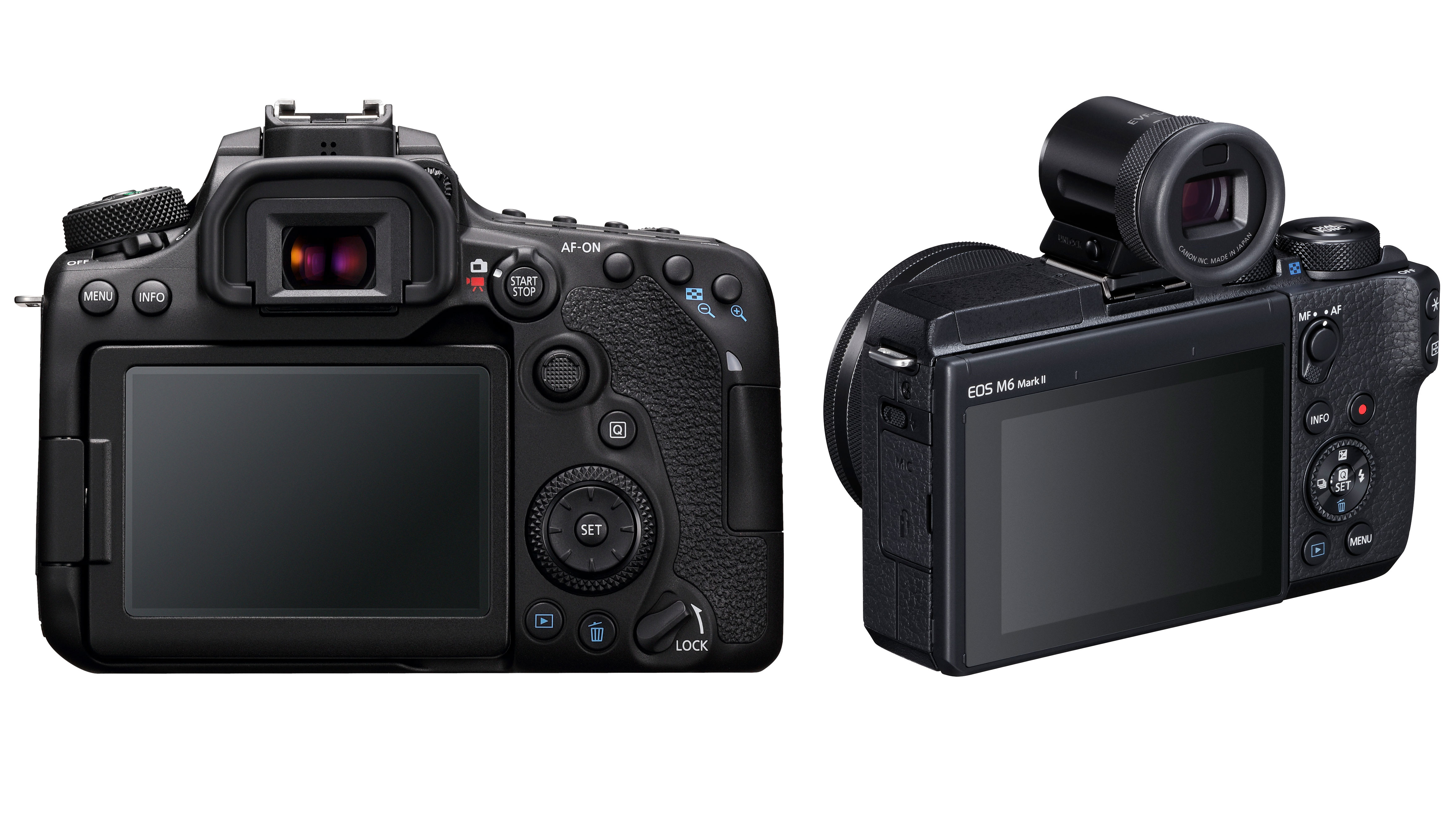
4. Viewfinder
| Header Cell - Column 0 | Canon EOS 90D | Canon EOS M6 Mark II |
|---|---|---|
| Viewfinder | Optical pentaprism, 100% coverage, 0.95x magnification | Optional, via clip-on EVF-DC2 EVF |
This is where the differences start. Being a DSLR, the EOS 90D has an optical viewfinder, and it’s a superior pentaprism type rather than the cheaper pentamirrors in DSLRs further down the range. It offers 100% coverage and 0.95x magnificatio. The EOS M6 Mark II, however, does not have a viewfinder at all. You can attach the clip-on EVF-DC2 electronic viewfinder, however. This is sold separately, but some retailers are offering it with the EOS M6 Mark II as part of a kit.
5. Rear screen
| Header Cell - Column 0 | Canon EOS 90D | Canon EOS M6 Mark II |
|---|---|---|
| Rear screen | 3-inch vari-angle touchscreen, 1.04m dots | 3-inch 180-degree tilting touchscreen, 1.04m dots |
We’re used to mirrorless cameras having more advanced rear screens than DSLRs, or at least with a wider range of movements, but the tables are turned here. Both cameras have a 3-inch 1.04M dot touchscreen display, but on the EOS M6 Mark II it’s on a titling hinge, albeit with a 180-degree ‘flip’ so that it can face forwards for selfies and vlogging. The EOS 90D, however, has a full-articulating vari-angle display which you can angle in pretty much any direction you like, including sideways.
6. Autofocus
| Header Cell - Column 0 | Canon EOS 90D | Canon EOS M6 Mark II |
|---|---|---|
| Autofocus | (Viewfinder) 45 cross-type with iTR focus tracking, (Live View) Dual Pixel CMOS AF | Dual Pixel CMOS AF |
Both cameras use Canon’s on-sensor Dual PIxel CMOS AF system. The EOS M6 relies on this entirely for both live view shooting and viewfinder photography (if you have a viewfinder attached). The EOS 90D uses the same Dual Pixel CMOS AF system in live view, so it’s just as effective as the EOS M6 Mark II for live view photography and autofocus for video. Being a DSLR, however, the EOS 90D also has a separate phase detection AF sensor for viewfinder shooting. This offers 45 cross-type AF points and Canon’s iTR focus tracking. We haven’t tested these cameras for their continuous AF abilities yet, but this could be a significant point of difference.
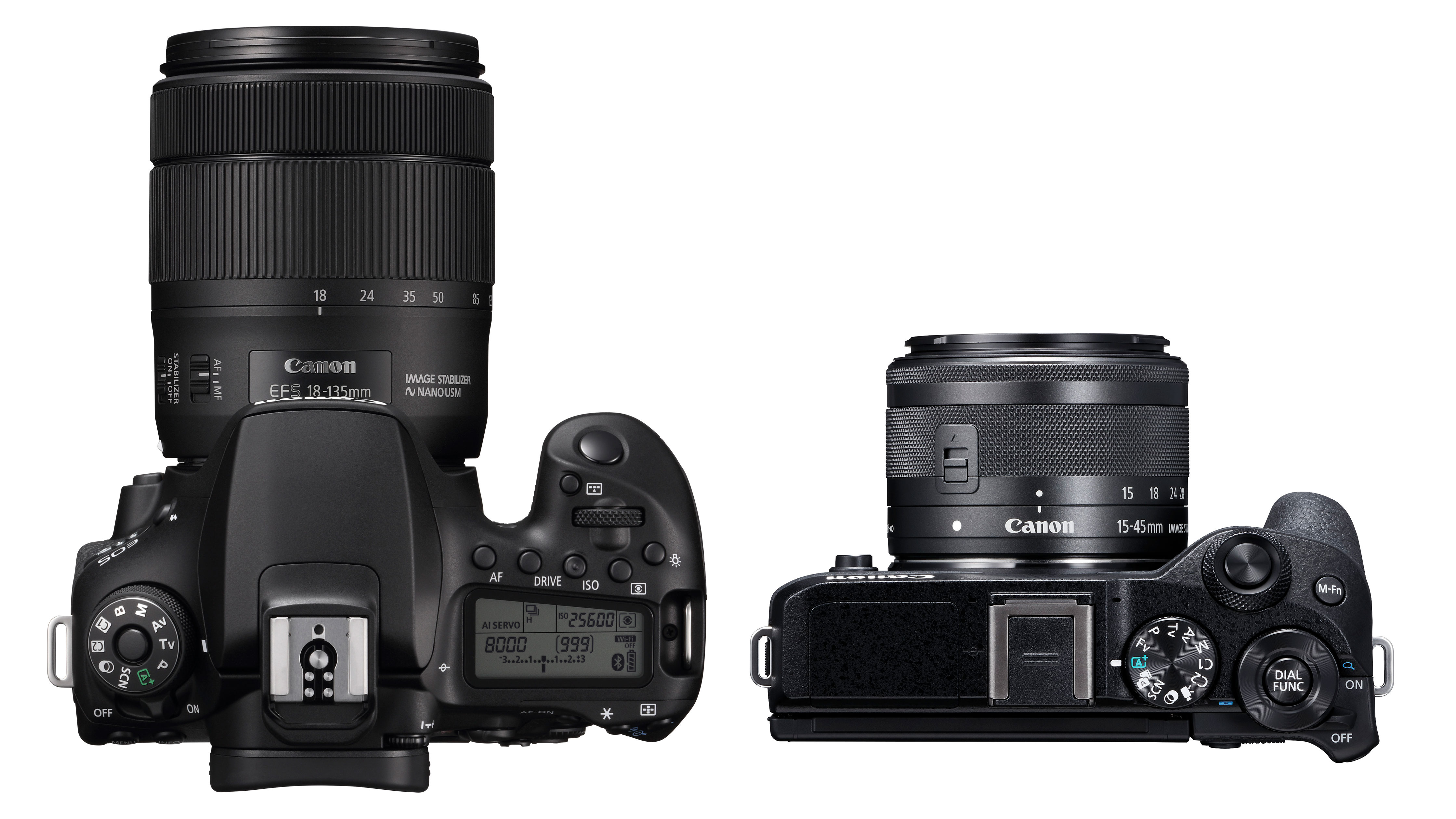
7. Shutter speeds
| Header Cell - Column 0 | Canon EOS 90D | Canon EOS M6 Mark II |
|---|---|---|
| Shutter speeds | 30-1/8,000sec plus B | 30-1/4,000sec plus B |
The Canon EOS 90D has a small advantage here too. The EOS M6 Mark II has a shutter speed range of 30-1/4000sec, but the EOS 90D goes even faster to 1/8000sec.
8. Continuous shooting
| Header Cell - Column 0 | Canon EOS 90D | Canon EOS M6 Mark II |
|---|---|---|
| Continuous shooting | 10fps, 58 JPEG, 25 raw, 11/7fps in Live View with S-AF/C-AF | 14fps, 54 JPEG, 23 raw (36 CRAW) |
You might expect the EOS 90D to be faster at continuous shooting too, but here the advantage swings back to the EOS M6 Mark II. The EOS 90D can capture images at 10 frames per second, which is very good indeed for a camera with this resolution, but has a pretty modest buffer capacity of 58 JPEGs or 25 raw files. The EOS M6 Mark II is faster, with a maximum shooting speed of 14fps, though with a slightly smaller buffer (thanks to the higher speed) of 54 JPEGs or 23 raw files – though it can capture 36 smaller CRAW files. The EOS M6 Mark II also has an intriguing 30fps RAW mode which we don’t know much about, except that it appears to be full automatic (it is on the Canon PowerShot G5 X Mark II) and not really an alternative to regular continuous shooting.
9. Video
| Header Cell - Column 0 | Canon EOS 90D | Canon EOS M6 Mark II |
|---|---|---|
| Video | 4K uncropped, 30/25p | 4K uncropped, 30/25p |
Both cameras have identical video specifications, capturing uncropped 4K UHD video at 30p or 25p, and both use Canon’s Dual Pixel CMOS AF system for live view AF while filming. If there is an advantage, you might expect it to lie with the mirrorless EOS M6 Mark II. In fact, it’s the DSLR that has the edge. The EOS 90D has a fully vari-angle LCD display, and while both cameras have microphone ports, it’s only the EOS 90D that has a headphone port for monitoring audio levels.
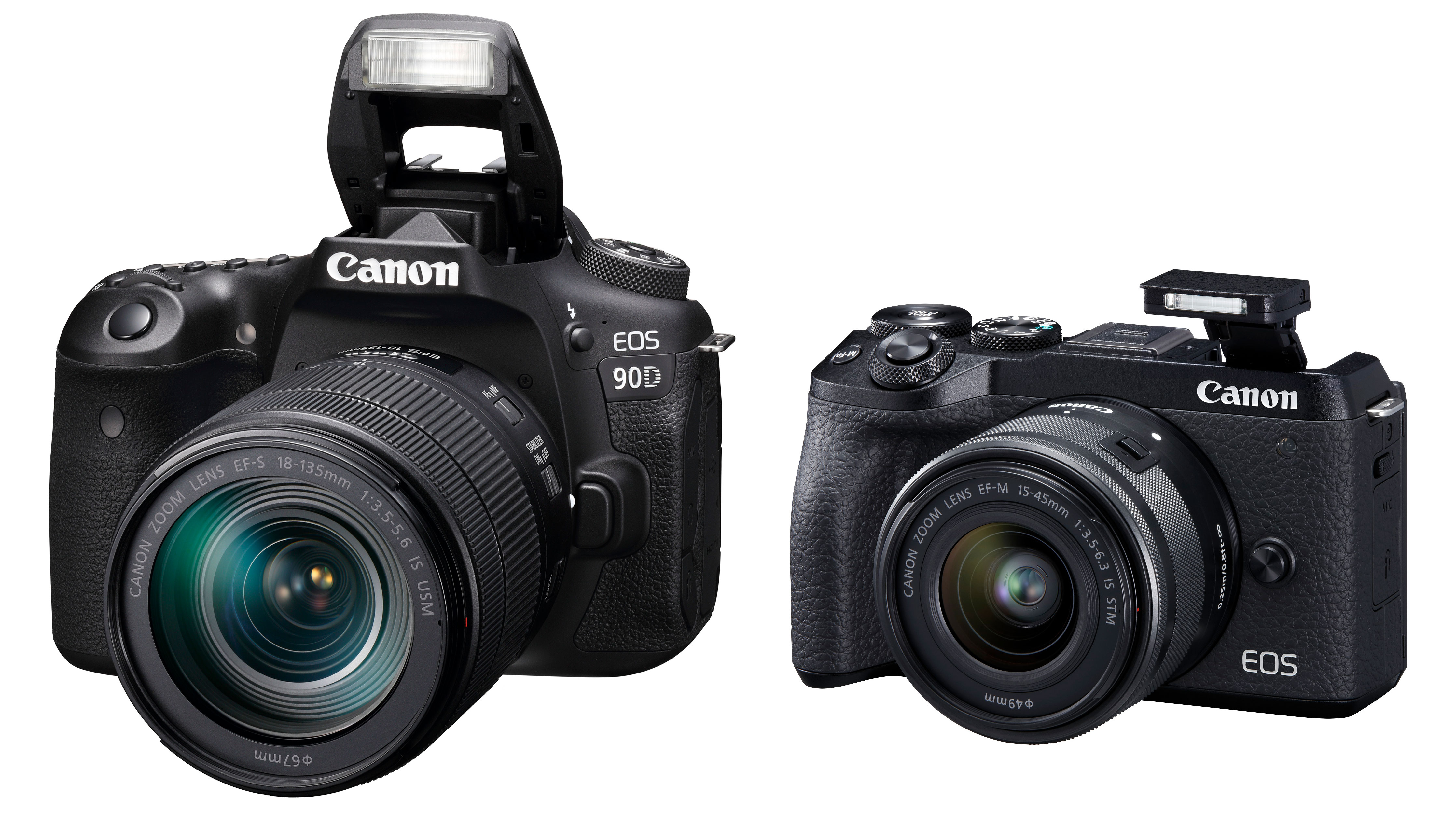
10. Flash
| Header Cell - Column 0 | Canon EOS 90D | Canon EOS M6 Mark II |
|---|---|---|
| Flash | Built in, GN 12 at ISO 100 | Built in, GN 4.6 at ISO 100 |
It’s another win for the EOS 90D for built in flash. Both cameras have a flash built in, but where the flash in the EOS 90D has a modest but effective Guide number of 12 at ISO 100, the flash in the EOS M6 Mark II is far weaker, with a Guide Number of 4.6 – you will have to ramp up the ISO or use some very fast lenses to get much illumination out of this.
11. Lens mount and choice
| Header Cell - Column 0 | Canon EOS 90D | Canon EOS M6 Mark II |
|---|---|---|
| Lens mount and choice | EF-S (all EF/EF-S lenses) | EOS M (8 native lenses, all EF/EF-S lenses via EF-EOS M adaptor) |
It’s another win for the EOS 90D – or the EOS M6 Mark II, depending on how you choose to look at it. The EOS 90D is directly compatible with the full range of Canon EF-S and EF lenses. That’s a lot of lenses. By contrast, there are only eight ‘native’ EF-M lenses for the Canon EOS M6 Mark II. That said, you can use the Canon EF-EOS M adaptor (sold separately but sometimes bundled) to open up the full range of EF-S and EF lenses on the EOS M6 Mark II as well.
12. Batteries
| Header Cell - Column 0 | Canon EOS 90D | Canon EOS M6 Mark II |
|---|---|---|
| Batteries | LP-E6N, 1,300 shots | LP-E17, 305 shots |
So now we’re on to batteries.... booooring! Except that it’s not. The EOS 90D can squeeze an extraordinary 1,300 shots out of its LP-E6N battery, while the EOS M6 Mark II can only scrape 305 shots from its LP-E17 cell. That’s not a small difference. The EOS 90D will last more than four times longer on a single charge for stills photography (we’d expect them to be the same for video, to be fair).
13. Dimensions
| Header Cell - Column 0 | Canon EOS 90D | Canon EOS M6 Mark II |
|---|---|---|
| Dimensions | 140.7 x 104.8 x 76.8mm | 119.6 x 70.0 x 49.2 mm |
Not surprisingly, the EOS 90D is a lot bigger than the EOS M6 Mark II. The M6 Mark II might conceivably fit into your coat pocket; the EOS 90D certainly won’t. On the ohter hand, if you’re using longer/heavier lenses, you might be glad of the extra grip and balance provided by the DSLR body.
14. Weight
| Header Cell - Column 0 | Canon EOS 90D | Canon EOS M6 Mark II |
|---|---|---|
| Weight | 701g | 408g |
It’s another unsurprising win for the Canon EOS M6 Mark II. The EOS 90D is not exactly a heavyweight, but the EOS M6 Mark II is not much more than half its weight. Of course, if you add an electronic viewfinder and the optional EF-EOS M lens adaptor, the equation changes somewhat.
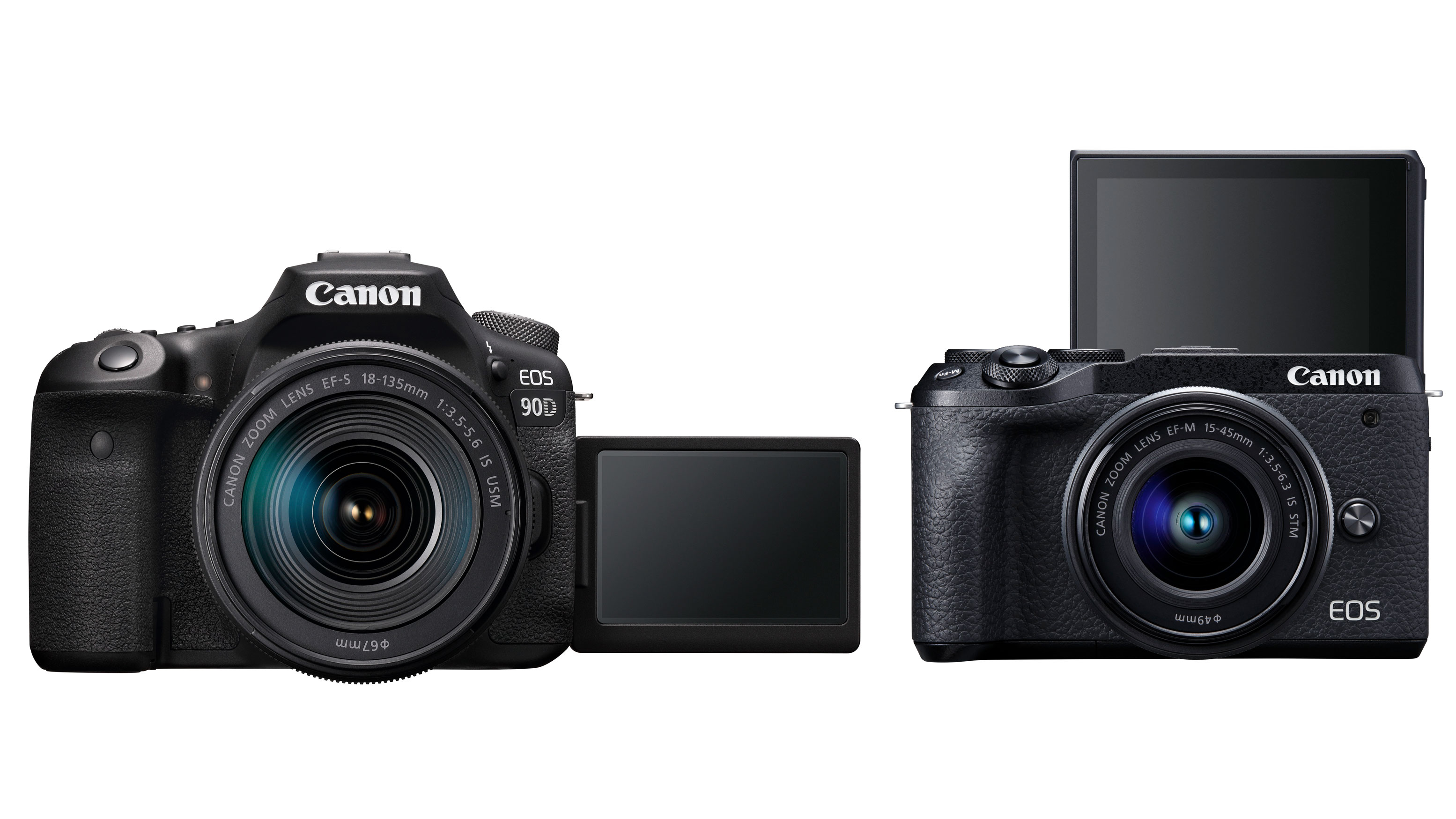
Verdict
This is not the simple comparison it might first appear. The EOS M6 Mark II is smaller, lighter and cheaper than the EOS 90D despite having essentially the same tech and capabilities. But the EOS 90D has a number of small and not so small advantages that do add up – and its DSLR design does not stop it being just as effective as a live view/video camera as any mirrorless model.
| Header Cell - Column 0 | Canon EOS 90D: reasons to choose it | Canon EOS M6 Mark II: reasons to choose it |
|---|---|---|
| Row 0 - Cell 0 | Optical viewfinder | Smaller |
| Row 1 - Cell 0 | 45-point phase-detection AF with iTR focus tracking | Lighter |
| Row 2 - Cell 0 | 1/8000sec fastest shutter speed | Cheaper |
| Row 3 - Cell 0 | Fully articulating rear screen | Same stills and video quality |
| Row 4 - Cell 0 | Headphone socket for audio monitoring | Faster 14fps continuous shooting |
| Row 5 - Cell 0 | More powerful flash | Row 5 - Cell 2 |
| Row 6 - Cell 0 | Better battery life | Row 6 - Cell 2 |
| Row 7 - Cell 0 | Better balance with big lenses | Row 7 - Cell 2 |
How we test cameras
We test mirrorless and DSLR cameras both in real-world shooting scenarios and in carefully controlled lab conditions. Our lab tests measure resolution, dynamic range and signal to noise ratio. Resolution is measured using ISO resolution charts, dynamic range is measured using DxO Analyzer test equipment and DxO Analyzer is also used for noise analysis across the camera's ISO range. We use these real-world testing and lab results to inform our comments in buying guides. For compact cameras and phones, we judge on real world handling and photographic results alone.
Read more:
• These are the best DSLRs you can get right now
• We pick the best mirrorless cameras on the market
• What's the best Canon camera? We pick our favorites
The best camera deals, reviews, product advice, and unmissable photography news, direct to your inbox!

Rod is an independent photography journalist and editor, and a long-standing Digital Camera World contributor, having previously worked as DCW's Group Reviews editor. Before that he has been technique editor on N-Photo, Head of Testing for the photography division and Camera Channel editor on TechRadar, as well as contributing to many other publications. He has been writing about photography technique, photo editing and digital cameras since they first appeared, and before that began his career writing about film photography. He has used and reviewed practically every interchangeable lens camera launched in the past 20 years, from entry-level DSLRs to medium format cameras, together with lenses, tripods, gimbals, light meters, camera bags and more. Rod has his own camera gear blog at fotovolo.com but also writes about photo-editing applications and techniques at lifeafterphotoshop.com
